
Opting for stylized graphics in favor of pure realism, Dreamfall offers breathtaking sights by providing an artistic vision. I love these fleeting scenes in the dreamscape where a pale Zoë finds herself in a near-monochromatic abyss ... like a painting come to life.
Review by Jay Wilson Like those nights when you lie in bed and sleep lingers just beyond your grasp, Dreamfall’s appeal remains elusive. The camera has a mind of its own and requires some adjustments in the options menu; the battle and stealth mechanism feel awkward and terribly primitive but, strangely enough, appropriate considering this is neither a battle nor stealth based game. Then as slumber finally slithers around your consciousness and takes hold, the charms of The Longest Journey’s sequel are unveiled like the unknowing surrender to a dream. In the brief prologue, Bryan Westhouse of the original game introduces us to this sequel and gives us just a taste of what awaits in the game-proper. And then we meet our protagonist, the young Zoë Castillo, college dropout extraordinaire whose sexy British accent is music to listen to (provided by Ellie Conrad-Leigh). We find her laying on her bed, half-dressed, watching TV, lost in the monotony of daily routines—same faces, same places, no direction—what’s the point of it all? She gives in more and more to apathy, lamenting that she’s not seen some of her friends in ages because she doesn’t feel like making any kind of extended trip ... 
The AI doesn't put up much of a fight once you get the hang of combat; however, if you still want a challenge, try getting stills via the print screen key while fighting.
... and she hates herself for it. Then after the obligatory introduction to her home of Casablanca, fate offers her a road to redemption when her good friend and ex-lover, Reza Temiz (an investigative reporter) vanishes. She vows to find him no matter what the cost. Thus she paradoxically touches the negative archetype of the spoiled rich girl who has everything, yet she simultaneously embodies the spirit of the poor everyman who refuses to surrender. She can walk away at any time and continue her comfortable lifestyle. Instead she chooses to fight her descent into irredeemable lethargy, she chooses to take the reins of her life back from autopilot. She chooses to make a stand. And, being a spoiled rich girl with no obligations, she has both the time and the resources to travel to hell and back. If that’s what it takes to save Reza—and, in doing so, save herself—then so be it. But Zoë is still just a lost soul, a college dropout, up against worlds-spanning corporate conspiracies. Thus, she is vulnerable. And because she’s vulnerable, suspenseful moments resonate with more intensity—when Zoë discovers a blood-splattered room or when armed guards chase after her, what is she going to do? She’s not a Lara Croft nor a BloodRayne. Make no mistake though—Zoë may be vulnerable, but she is not helpless. Throughout the game, Ms. Castillo will call upon her wits, her charms, and (every once in awhile) her fists to get herself out of a bind. Because she’s not helpless, she chooses to embark on this journey despite her weaknesses, despite being way out of her league, despite the apparent hopelessness of the task. “I may not like the Zoë I’m becoming,” she tells one of Reza’s contacts, “but I couldn’t live with the Zoë who does nothing when her friends need her.” 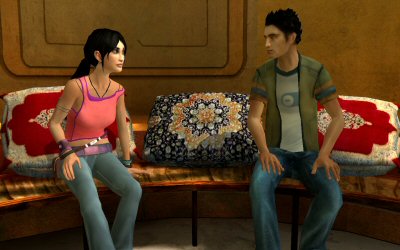
Dreamfall’s story follows the classical noir formula of the protagonist (Zoë) following the footsteps of a missing friend (Reza) to find out what really happened to him.
This journey will lead Zoë to a rundown location in Newport, Venice, with familiar faces in familiar places for TLJ fans—Charlie, Emma, the Border House, and the Fringe. We even get to revisit the very room from which the original game began. But, unfortunately for Zoë, none of the clues she picks up seem to get her any closer to Reza. Then to make matters worse, she wakes up in another reality entirely with no idea how she got there (or how to get back, for that matter.) We, of course, know from the original game she has crossed the divide to the magical parallel world of Arcadia, and we know it’s only a matter of time before the heroines of Dreamfall and The Longest Journey meet face to face. First we hear April, and then we see her. Sarah Hamilton reprises her role as the dual-worlds saving shifter, April Ryan, and hearing her voice again after eight years I marveled how vividly I remembered this character. She briefly explains the parallels worlds—one of science (Stark) and one of magic (Arcadia)—and helps Zoë return to her world (Stark) so she can continue her search for Reza. Then the narrative briefly changes hands to April Ryan who goes on to investigate a brewing conspiracy in Arcadia while dealing with her own emotional turmoil (saving the twin worlds takes its toll on a girl, you know). 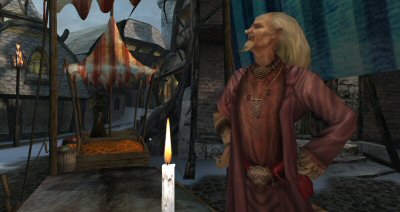
Many of the Arcadian side characters are devilishly tongue-in-cheek and charming as all hell such as Roper F. Klacks, reformed evil wizard and published author.
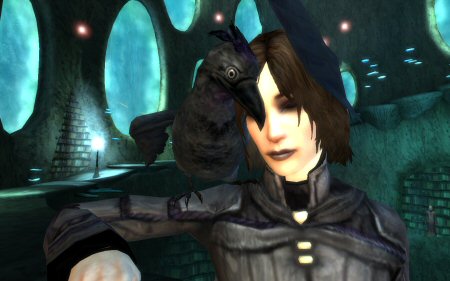
Truth be told, Dreamfall really isn’t much of a game, rather a linear story with deeply sympathetic and engaging characters which you happen to control from time to time.
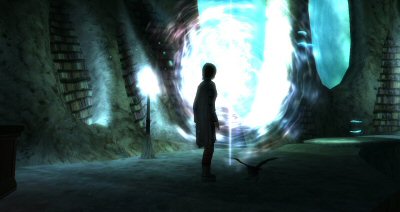
I didn’t realize how much I missed the TLJ gang until I played Dreamfall. It was heartwarming crossing the divide again with April and Crow. Now I want to go replay The Longest Journey (again)
Zoë and April’s journeys bring both women to dungeons they must explore alone in their respective worlds—Zoë into a secret underground lab, April into ancient ruins of a forgotten civilization. The narrative masterfully cuts between them, revealing through juxtaposition that both dungeons are linked—that the threat in Stark which swallowed Reza has a mirror image in Arcadia—yet the game never answers how. By and large, Dreamfall is a darker game with a much bleaker tone and vision than its predecessor. Although, the narrative does gives us a taste of the original game’s flavor with a colorful cast. There’s Theoretically-blind Bob, who might have lost his vision had the spell not missed him by a mile, but that doesn’t stop him from posing as a blind beggar. In the market, while questing, Zoë runs into the wonderful-fantastic Spice Merchant whose (wonderful!) upbeat sales pitch and optimism (fantastic!) can make any predicament sound cheerful (wonderful!). The evil wizard from the first game shows up as a merchant in Old Town selling “Herbs! Potions! Curiously shaped cookies!” Just enough to reminds us that yes, indeed, this is still a part of The Longest Journey saga. With the return of April also comes the return of the lovable sidekick, Crow (again voiced by Roger Raines). And, yes, he’s still got the gift of the gab. “My beak is a finely tuned instrument of love.” He tells Zoë, “When I speak, girls tremble ... also guys. Guys tremble too, but not in the same way.” And when the White of the Draic Kin opens a shift to the Guardian’s Realm, I smiled seeing the camera pan down showing April and Crow in silhouette against the magical portal. Arriving in familiar territory where the climax of TLJ took place, Crow looks around and notes, “Jeepers this place has changed a lot. It used to scare the crap out of me, and now it’s sorta ... fluffy ... with an edge.” (whatever the hell that’s supposed to mean.) However, the nostalgia serves a more sinister purpose—to show that that era of Stark and Arcadia’s history has passed away. Despite a few brief detours with April, Dreamfall is Zoë’s tale to the point that even the game mechanics take a backseat to her development and storyline. Day has given way to night, and as Zoë progresses further and further along Reza’s trail the tongue-in-cheek tone of The Longest Journey soon surrenders to the darkness of Dreamfall. We remember what was spoken in The Longest Journey’s prologue, “the best stories begin where they end” ... and, remembering Dreamfall’s beginning, we know where it must end. 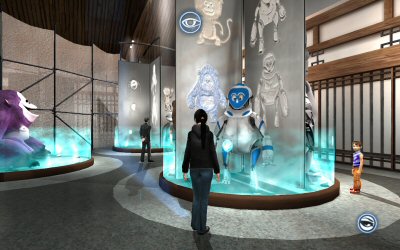
The focus field (the blue line on the floor) allows Zoë to observe and examine items from a distance, bringing the old 2D point-and-click adventure interface into the world of 3D third person.
I’ve always been drawn to the darker narratives, I guess, because noble themes of valor, chivalry, honor, and glory strike me as ideals and not reality which makes it nigh impossible for me to relate. Classical archetypes in that vein can have their own charm, of course ... but it’s the darkness that keeps the stories intimate and makes the characters real. The light makes the characters sympathetic—something we can aspire towards—but it’s the darkness that lets you relate to them in the first place. Greek Tragedies, after all, explored human weaknesses more so than their strengths. There’s a darkness in The Longest Journey, and much more so in Dreamfall, that allows these characters and their storylines to resonate on a more personal, intimate level despite the epic scope of April and Zoë’s adventures. And the two games have a curious interaction with one another—the darkness of Dreamfall ripples back into The Longest Journey adding a layer of depth with its inky black shadows (the psychological consequences of Fate’s burden), and yet a light burns from within the heart of the first game to give hope throughout the events of its bleak sequel (we know the ending has yet to be written when Dreamfall closes.) 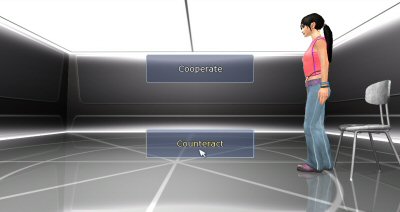
I’m tired of playing games with numerous elaborate dialog choices that lead to the exact same responses. Dreamfall’s scaled back options strikes me as refreshingly honest. Thank you, Ragnar Tørnquist.
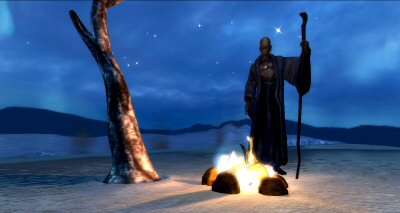
"...Is but a dream within a dream."
— Edgar Allen Poe But what stands out most about Dreamfall, intrigues and fascinates me, draws me to it, and compels me to play it through a fourth time now? That it doesn’t feel like you’re interacting with a video game. Dreamfall features a combat and a stealth system, but the awkward execution feels more like a faded memory of the real thing ... not unlike a dream. Zoë engages in conversation, but the player has very little impact on what gets said. For example, during an interrogation, the player’s choice is between “cooperate” and “counteract.” Ultimately, the destination is the same, but Zoë’s tone differs ... like a dream you can influence, but not outright control. All things add up in such a way that the gameplay feels like a nightmarish freefall, and even though you have the power to reach out ... you’re still at the mercy of the dream, for the nightmare might not provide you anything to grab on to. And when you’ve hit the bottom of that black abyss, waking up in a cold sweat feeling like you just got hit by a train, you ponder what those images could mean ... ... and thus the dream haunts your consciousness long after you wake up. | ||||||||||||||||||||
|
| ||||||||||||||||||||
